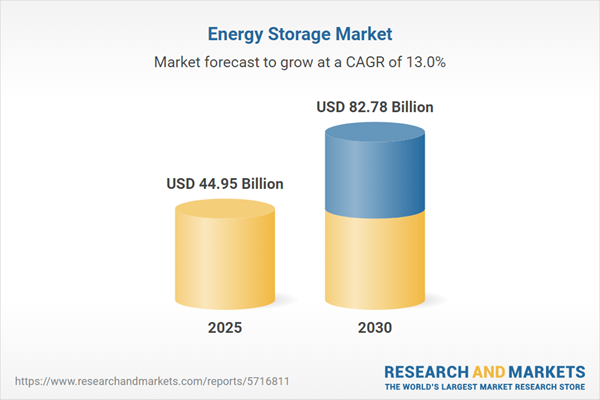Energy storage, or electricity storage, involves capturing energy from renewable and non-renewable sources for discharge when needed, enabling greater flexibility and control over electricity usage. It addresses traditional barriers to continuous energy supply, promoting self-sufficiency and balancing supply and demand. The growing popularity of energy storage stems from increasing demand for renewable energy, supportive government policies, rising global power consumption, heavy public-private investment, improving storage economics, rapid industrialization in developing countries, and increased use of energy storage systems (ESS) in transportation. However, high installation and capital costs for deployment remain significant challenges for market growth.
Market Drivers
Battery Segment Growth
The transition to sustainable energy systems is driving demand for battery energy storage systems (BESS), which are critical for controlling voltage and frequency, reducing peak demand costs, integrating renewable energy sources, and providing backup power. Batteries constitute the majority of ESS costs, with lithium-ion, lead-acid, nickel-cadmium, and flow batteries being the primary types used. Lithium-ion batteries are experiencing significant demand growth due to their declining costs, with the U.S. Department of Energy setting a target price of USD 125/kWh by 2030, while projections suggest prices could reach USD 73/kWh by that year. Their advantages include low maintenance, lightweight design, consistent cycle life, high energy density, and efficient charge-discharge cycles, positioning lithium-ion batteries to dominate the battery energy storage market.Geographical Outlook
Asia Pacific Market Dominance
The Asia Pacific region is expected to hold a significant share of the energy storage market over the forecast period. The region features a mix of advanced economies like Japan, South Korea, New Zealand, and Australia, with reliable, modern power grids, alongside developing nations with less robust infrastructure. Rapid urbanization and population growth in developing countries are projected to increase power demand significantly. For instance, India aims to achieve 275 GW of combined wind and solar capacity, 72 GW of hydropower, and 15 GW of nuclear power by 2027, driving demand for ESS to manage the intermittent nature of renewable energy.In South Korea, the 8th Basic Plan for Electricity Supply and Demand forecasts a reduced annual electricity demand growth of 1% through 2030. The government is focusing on energy-saving measures, integrating renewable energy with ESS, and reducing greenhouse gas emissions to combat fine dust pollution. In China, plans announced in 2021 target non-pumped hydropower storage capacity of 30 GW by 2025 and 100 GW by 2030. Additionally, China's adoption of time-of-use power tariffs, which widen the gap between peak and off-peak rates, is expected to accelerate growth in the battery storage sector. These factors collectively position the Asia Pacific as a key growth region for energy storage, driven by ambitious renewable energy targets and supportive policy frameworks.
Key Benefits of this Report:
- Insightful Analysis: Gain detailed market insights covering major as well as emerging geographical regions, focusing on customer segments, government policies and socio-economic factors, consumer preferences, industry verticals, and other sub-segments.
- Competitive Landscape: Understand the strategic maneuvers employed by key players globally to understand possible market penetration with the correct strategy.
- Market Drivers & Future Trends: Explore the dynamic factors and pivotal market trends and how they will shape future market developments.
- Actionable Recommendations: Utilize the insights to exercise strategic decisions to uncover new business streams and revenues in a dynamic environment.
- Caters to a Wide Audience: Beneficial and cost-effective for startups, research institutions, consultants, SMEs, and large enterprises.
What do businesses use our reports for?
Industry and Market Insights, Opportunity Assessment, Product Demand Forecasting, Market Entry Strategy, Geographical Expansion, Capital Investment Decisions, Regulatory Framework & Implications, New Product Development, Competitive IntelligenceReport Coverage:
- Historical data from 2022 to 2024 & forecast data from 2025 to 2030
- Growth Opportunities, Challenges, Supply Chain Outlook, Regulatory Framework, and Trend Analysis
- Competitive Positioning, Strategies, and Market Share Analysis
- Revenue Growth and Forecast Assessment of segments and regions including countries
- Company Profiling (Strategies, Products, Financial Information, and Key Developments among others).
Energy Storage Market Segmentation
By Technology
- Thermal Storage
- Battery Energy Storage
- Pumped Storage Hydropower
- Compressed Air Energy Storage
- Flywheel
- Others
By Deployment
- Off-Grid
- On-Grid
By End-User
- Residential
- Commercial
- Industrial
By Geography
- North America
- United States
- Canada
- Mexico
- South America
- Brazil
- Argentina
- Others
- Europe
- UK
- Germany
- France
- Italy
- Spain
- Others
- Middle East and Africa (MEA)
- Saudi Arabia
- UAE
- Israel
- Others
- Asia Pacific
- China
- Japan
- South Korea
- India
- Indonesia
- Thailand
- Taiwan
- Others
Table of Contents
Companies Mentioned
- LG Corporation
- ABB Ltd.
- The AES Corporation
- BYD Company Ltd.
- Toshiba Corporation
- Convergent Energy and Power
- Eos Energy Storage Inc.
- GS Yuasa International Ltd.
- Johnson Controls
- Contemporary Amperex Technology Co. Ltd.
Table Information
| Report Attribute | Details |
|---|---|
| No. of Pages | 145 |
| Published | June 2025 |
| Forecast Period | 2025 - 2030 |
| Estimated Market Value ( USD | $ 44.95 Billion |
| Forecasted Market Value ( USD | $ 82.78 Billion |
| Compound Annual Growth Rate | 12.9% |
| Regions Covered | Global |
| No. of Companies Mentioned | 10 |









